Review of Art School Orgy by Stewart Home
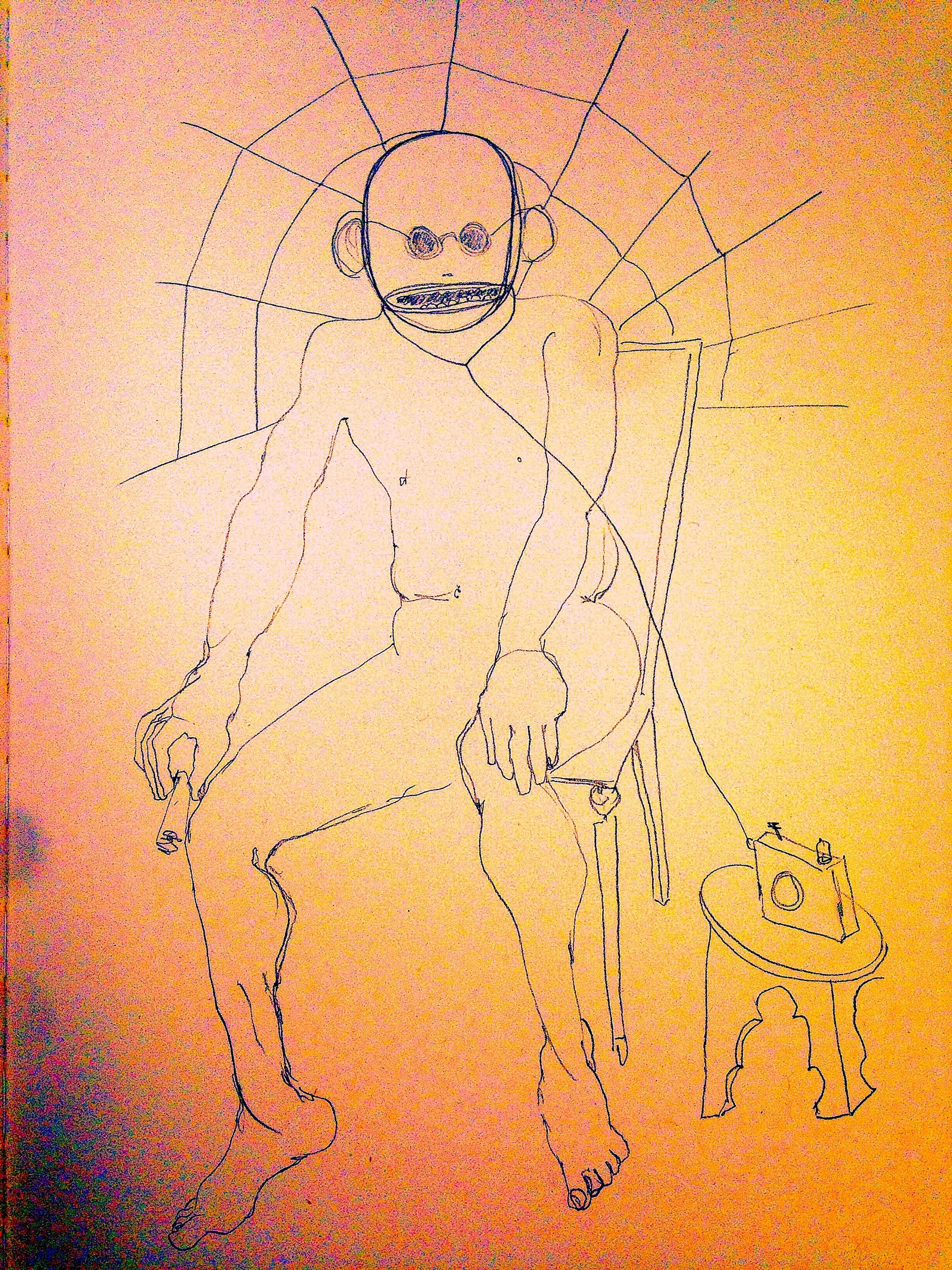
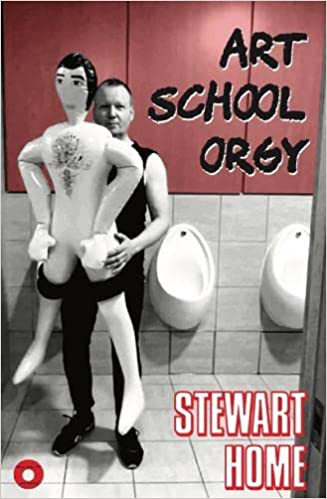
Stewart Home: Art School Orgy
Home has written another Sadean revolutionary novel of perverse jouissance and unhinged hard-core from the dark Enlightenment . It places Home, yet again, in the company of modern Utopian art practices in a tradition ‘running from the Free Spirit through the writings of Winstanley, Coppe, Sade, Fourier, Lautreamont, William Morris, Alfred Jarry, and on into Futurism and Dada--then via Surrealism into Lettrism, the various Situationist movements, Fluxus, ‘Mail Art’, Punk Rock, Neoism and contemporary anarchist cults’. It also places him in a Sadeian literary tradition that runs forward to the present from a dark Enlightenment via Sterne, Laclos, Voltaire, Richardson, Diderot, Cervantes, Boccaccio, Marivaux, Mdme de LaFayette, Monk Lewis, Mrs Radcliffe, De Sade, Proust, Kundera, Borges, Beckett and Kafka – to mention just a few of its deranged picaresque spirits, and back before then to its infernal origins in Dante.
Referencing these two intertwined but separate traditions – utopian art practices and Sadean dark Enlightenment literature - helps readers navigate a hugely fascinating text and guards us from regarding it as simply a chunk of strange same-sex pornography, or a spectral joke send-up of ‘Shades of Grey’-type erotica, even though it accommodates both readings as partially on the money.
Sex and violence are yet again the centre of gravity and as always, as Home himself wrote when discussing the novels of Richard Allen, in an interesting essay “Gender Sexuality and Control: Richard Allen Reconsidered” , violence is “. . . a violence with a dualistic nature. It is simultaneously mechanical and mystical. It is beyond the control of those who vent it, but it is destined to be neutralised by some outside authority, usually the police, at the conclusion of the story. . . ” In this new novel the violence is an s & m orgy routine spanning the whole book whereby it’s outside authority controls and ‘vents it’ and the simultaneity of occult and mechanical derangements ends only in the final moments where the sub is released into the perverse and evil mainstream of capitalism.
‘Only beyond speculation can we find Eden’ writes fellow Sadean writer Beckett in a letter to Morris Sinclair back in the thirties. Hence Home writes his great sequence of depraved picaresque novels across a span of decades, starting with Pure Mania in 1989 and then through Defiant Pose , Red London , Slow Death, Come Before Christ and Murder Love, Cunt , Whips & Furs: My Life as a bon-vivant, gambler & love rat by Jesus H. Christ , 69 Things to Do with a Dead Princess, Down and Out in Shoreditch and Hoxton , Tainted Love , Memphis Underground , Blood Rites of the Bourgeoisie Mandy, Charlie & Mary-Jane , The 9 Lives of Ray The Cat Jones, She's My Witch to this new outing, Art School Orgy.
It was de Sade who rhetorically asked the question: “Of what use are novels?’ and gave his answer: ‘ Hypocritical and perverse men, for you alone ask this ridiculous question: they are useful in portraying you as you are, proud creatures who wish to elude the painter’s brush, since you fear the results, for the novel is – if t’is possible to express oneself thus wise – the representation of secular customs, and is therefore, for the philosopher who wishes to understand man, as essential as is the knowledge of history. For the etching needle of history only depicts man when he reveals himself publically, and then ‘tis no longer he: ambition, pride cover his brow with a mask which portrays for us naught but these two passions, and not the man.’
And flowing from this, de Sade, brooding on the requirements for writing a decent novel, forbids the writer to stray from verisimilitude. We’ll come to the lit tradition in a bit. But first let’s start with the general art one because this is from where the novel takes its cues.
Home has given clues as to how he sees his place in the Utopian art scene via a huge range of non-fiction texts, beginning with his seminal The Assault on Culture: Utopian currents from Lettrisme to Class War in 1988 and continuing with Neoist Manifestos ; Cranked up Really High: Genre Theory And Punk Rock; Conspiracies, Cover-Ups and Diversions: A Collection of Lies, Hoaxes and Hidden Truths ; Green Apocalypse (a critique of the magazine and organisation Green Anarchist) with Luther Blissett ; Analecta ;Neoism, Plagiarism and Praxis ; The House of Nine Squares: Letters on Neoism, Psychogeography And Epistemological Trepidation, with Florian Cramer; Disputations on Art, Anarchy and Assholism ; Confusion Incorporated: A Collection of Lies, Hoaxes & Hidden Truths ; Repetitions: A Collection of Proletarian Pleasures Ranging from Rodent Worship to Ethical Relativism Appended with a Critique of Unicursal Reason ; Anamorphosis: Stewart Home, Searchlight and the plot to destroy civilization ; Jean Baudrillard and the Psychogeography of Nudism ; Fasting on SPAM and Other Non-aligned Diets for Our Electronic Age ; The Intelligent Person's Guide to Changing a Lightbulb ; The Correct Way to Boil Water ; The Easy Way to Falsify Your Credit Rating to Re-Enter The Dragon: Genre Theory, Brucesploitation & the Sleazy Joys of Lowbrow Cinema .
David Hockney is, as all art lovers know, one of the art world’s celebrity superstars. It’s important to know this if the joke is to be appreciated. Kitaj and other celebrity artists of the sixties are also names Home uses to scum up the works. Art jokes are a thing in contemporary art and so it’s obviously important to note that we should read the book as an art joke as well as anything else. As legendary art critic and artist Matthew Collings says in his ‘This Is Modern Art’ book, ‘ There are many jokes in Modern Art. They are never all that funny.’ So it’s right that Home is parodying the art joke by making a joke out of David Hockney, Kitaj and the rest whilst not being all that funny. There are never any belly laughs in Home.
Collings is helpful in giving us the top ten types of art jokes: ‘… number one would be jokes that are either outrageously obvious or outrageously obscure. Or both. No 2: (haha) jokes about shit. No 3: jokes about sex; No 4: jokes about bottoms; No 5: jokes about ivory towers; No 6: jokes about any old rubbish; No 7: jokes in French, often based on asinine puns or wordplays; No 8: jokes about the mystery of language (related to the last type but more mysterious); No 9: Zen jokes. The tenth category might be the repetition of No. 9 in a droning, annoying way, like the repetition of the words ‘number nine’ on Revolution Number Nine by the Beatles which was influenced by Yoko Ono, who was a member of the Fluxus movement.'
If we read Home carefully we will find all of these jokes, but especially 2, 3, 4 and 5 in the present novel where we suppose the ivory tower here is the art establishment. But it could well be other things too. As with most art jokes, we can’t be sure whether we’ve got the joke. With Home this is always the case. So reading him is always something that leaves you feeling a little uneasy, as if there is something lurking about that is pointing to you and taking the piss. That’s the ‘epistemological trepidation’ he likes to remind us about.
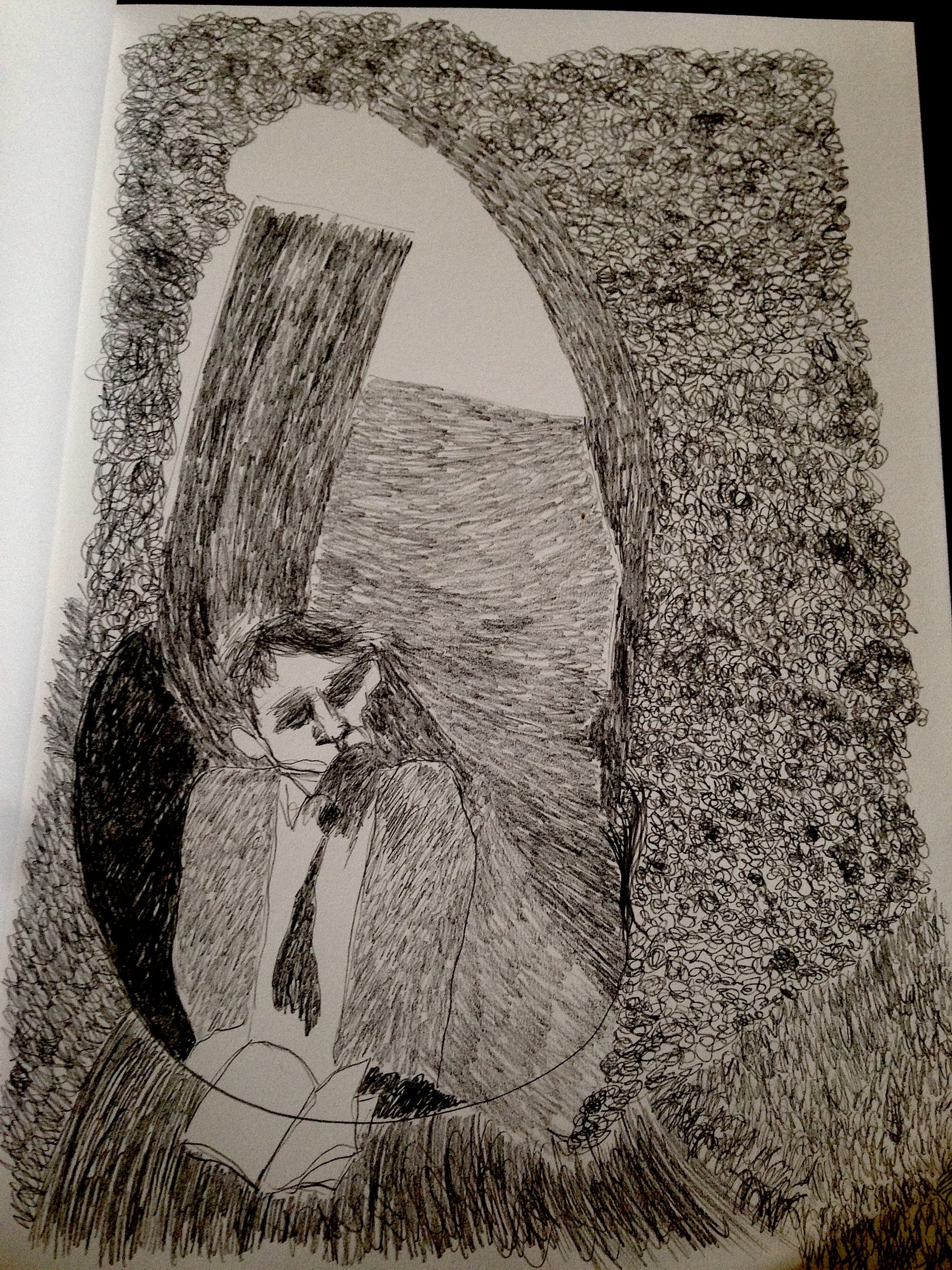
‘The fascination of pictures is the fascination of being seduced by a dead object, it is the magic of disappearance, and this particular magic can be found just as easily in pornographic images as in modern art, where the prevailing obsession has been to literally not be viewable, to defy any and all possibilities of visual seduction....’ says Baudrillard in The Transparency of Evil. Somewhere in the joke is this point. We are off to the races now, where we fall down the rabbit hole of a contemporary art that functions as the religion of the world, a form of knowledge and a legitimated form of male emotionality. So let’s follow these thoughts.
In the art world the male is heroicized by displaying female traits and art bohemia generalises to underground space generally and is just a colonised space of men possessed of genius. These characters and these spaces have latched onto the idea of utopian currents running , as Home has pointed out many many times before (keep up), from the Free Spirit, Winstanley, Coppe, Sade, Fourier, Lautreamont, William Morris, Alfred Jarry, Futurism, surrealism, Lettrism, Situationism, Fluxus, Mail Art, Punk Rock, Neoism, and anarchist cults to the gender wars, but then have closed off the world and become inward, self obsessed and barren. They have functioned to suppress rather than enable the utopian currents and spirits. Home is therefore out to stir up trouble because he has noticed that there’s a crisis in the world caused by capitalism and rich artists aren’t the solution.
‘The Republican College of Art was a moderate-sized art school. There might have been some two or three hundred postgraduates studying there when our rapscallion David Hockney appeared there as a freshman. Of these, unfortunately for the art school, there were a very large proportion of the gentleman-commoners. Enough, in fact, with the other men whom they drew round them, and who lived pretty much as they did, to form the largest and leading set in the college. So the art school was decidedly fast.’
Thus Home begins his story . It’s all a hypothesis that doesn’t ask whether history bears out the narrative but rather asks whether we can see what’s happening right now and what has to be done in the world beyond art. Home is our merry prankster who writes to wreck the venerable cities of the God Art in the grand fucked-over tradition of the First Futurist Manifesto which required that we ‘… take up your pickaxes, your axes and hammers and wreck, wreck the venerable cities, pitilessly.’
He approves of Dadaist Richard Huelsenbeck when he writes:’ The Dadaist considers it necessary to come out against art because he has seen through its fraud as a moral safety valve.’ The revolutionary element is often greater than its constructive element. The question becomes what the objective of all this is. Is it destruction of art or rather the integration of art with life and then, further, with all human activities? Home hovers in this precinct and thus his work can be seen as a species of art heresy - so long as it requires us to act on Utopian principles.
Critics and galleries, mainstream publishing houses and event venues are not part of his heretical tradition however, and so are implacably his enemy. Even those who focus on self-publicity, on working at art outside of the mainstream of art production and presentation aren’t part of his tradition either because they limit themselves to the production of art and not the transformation of society according to utopian ideals. When he demands that we ‘abolish all serious culture’ that’s what he means.
David Hockney represents the art high snob enemy, the artist whose work is insular and circumscribed by its sole focus - art. Home is once more working to crack the ice of what he calls elsewhere the ‘Bretonian glaciation whose negative influence on the utopian tradition was not dissimilar to the effects of Stalinisation on the workers movement.’ The tradition that Home is working in, or has created to work within, or has discovered he is working in, is one opposed to consumer capitalism, but of course it emerges from and is situated slap bang in the middle of this culture. As such, Home can’t help finding himself tangled in the market place. That’s inevitable.
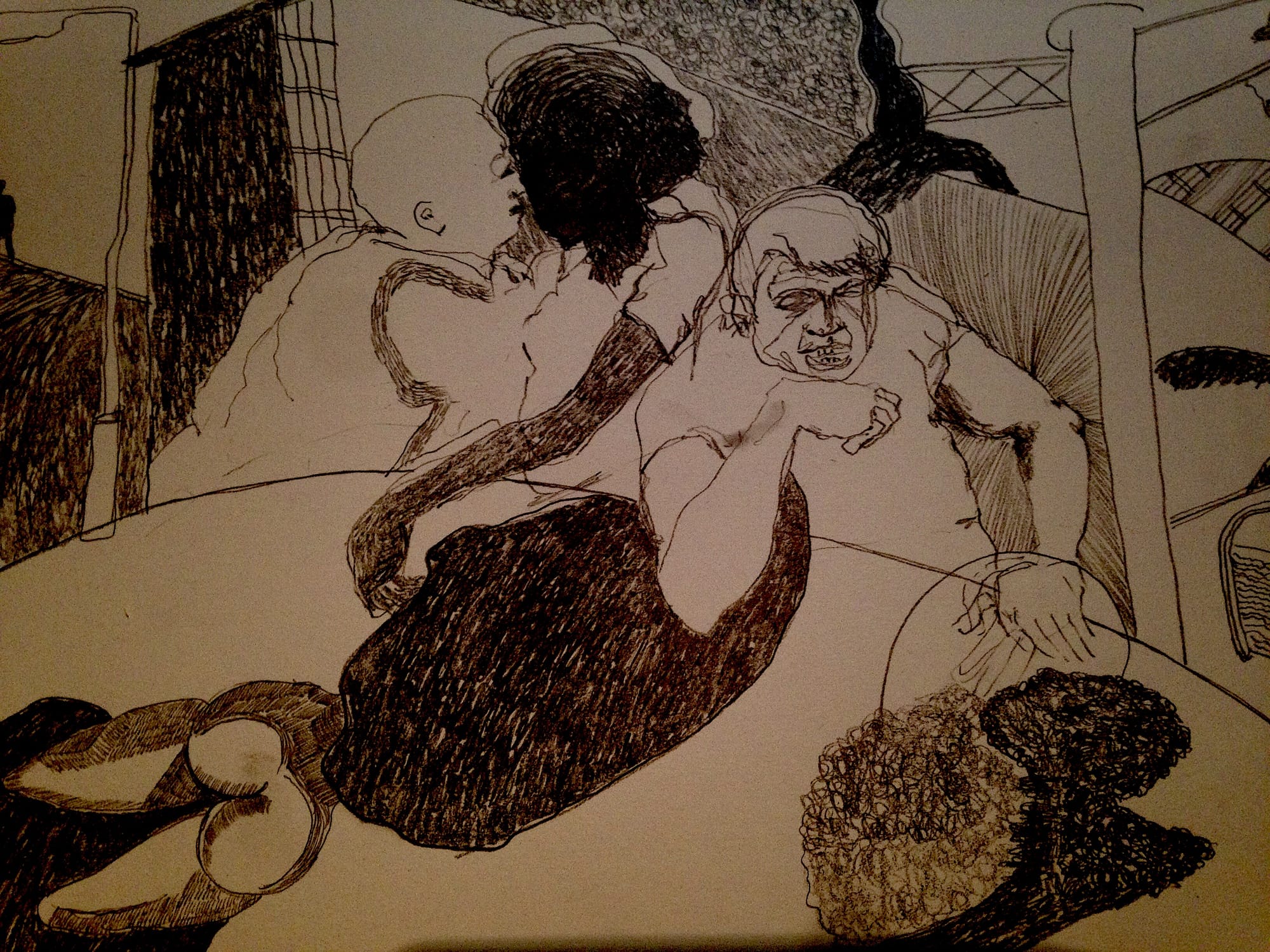
In ‘Orgy’ he’s back doing what he does best, cranking up perfectly the inherent waste inherent in a society based on planned obsolescence and being innovative. So if he’s not totally breaking with the ideology of the reigning society – how could he? how could anyone? – he’s doing enough to show us a perspective that corrodes it from the inside. If its art he’s doing – after all, it is a novel and he does want you all to go out and buy it – and you should – it’s analogous to those religious heretics working outside the church to reimagine the utopian spirit that religion can embody on the outside. (Think of all those Catholic priests killed by the CIA in central and South America as they re-imagined the utopian Christianity as an occult Marxism.)
The novel kicks off by schematising many of these themes via a Royal College of Art scene setting. And he introduces us to his own David Hockney, who of course shares the name and art trajectory with the famous David Hockney who is the darling of the high art set and is one of the world’s richest and most famous artists. And immediately we are plunged into a familiar Home world where juxtaposed theory and character-dialogue orientates the reader towards the rest of the journey.
‘Mark was now curled up on one end of the bench reading Les Chants de Maldoror and getting into the vagaries of shark sex. Presently, Hockney heard something between a groan and a protest, and, looking up, demanded explanations. Mark, in a voice half furious and half fearful, that unmistakably belonged to a young man who’d grown up in Newcastle, read out: there are some who write seeking the commendation of their fellows by means of noble sentiments which their imaginations invent or they possibly may possess. But I set my genius to portray the pleasures of cruelty! Cannot genius be cruelty’s ally in the secret resolutions of Providence? Or, if cruel, can’t one possess genius? My words will provide the proof; all you need do is listen to them, if you like... “You don’t mean to say that’s Lautréamont’s view of humanity?” Armstrong asked. “Yes!”
“What a cold-blooded old Philistine,” said Hockney. “Do you think it could be true?” Mark asked.
“I don’t want to think about that,” Armstrong said flatly. “I’m going to see if I can find a pair of labourers who’ll let me take turns sucking them off , while they take turns beating my bottom with this cricket bat.” After some personal reflections on Lautréamont once Armstrong had left in search of cock, Geordie and Hockney then and there resolved that, so far as they were concerned, it was not, could not, and should not be true. They would remain the greatest friends in the world.’
The origin of the work is dialectical, as the passage makes clear. It also leans heavily on rejecting spurious doctrines more because they’re doctrines than that they are spurious. When Armstrong goes off here we are given the utopian trope emerging swiftly and in no-nonsense prose: surrealist experiment must take place in the context of the everyday. Hence we are bombarded throughout with literary texts, studies in popular culture, theoretical elaboration of experimental platforms, the unprecedented emptiness that pushes art relentlessly into a position of market dependence and decisively moves from utopian currents to individualism, imagination and desire, vital expression yoked to money markets and male genius tropes constantly jammed up against ‘everyday life’.
The gentlemanly hours, the boating on the Serpentine (one of the brilliant things about the book are the London scenes and settings Home turns into activities of set-piece ethnology, where the efficient dialogue propels the reader into a spare and remorselessly efficient common language wielded to ensure that nothing is mistaken for naturalism nor realism. Here psychic automism is grafted inorganically to physical automism as if explication is a physical act which materialises thought and codes the triple threats of surrealism, abstraction and social realism.
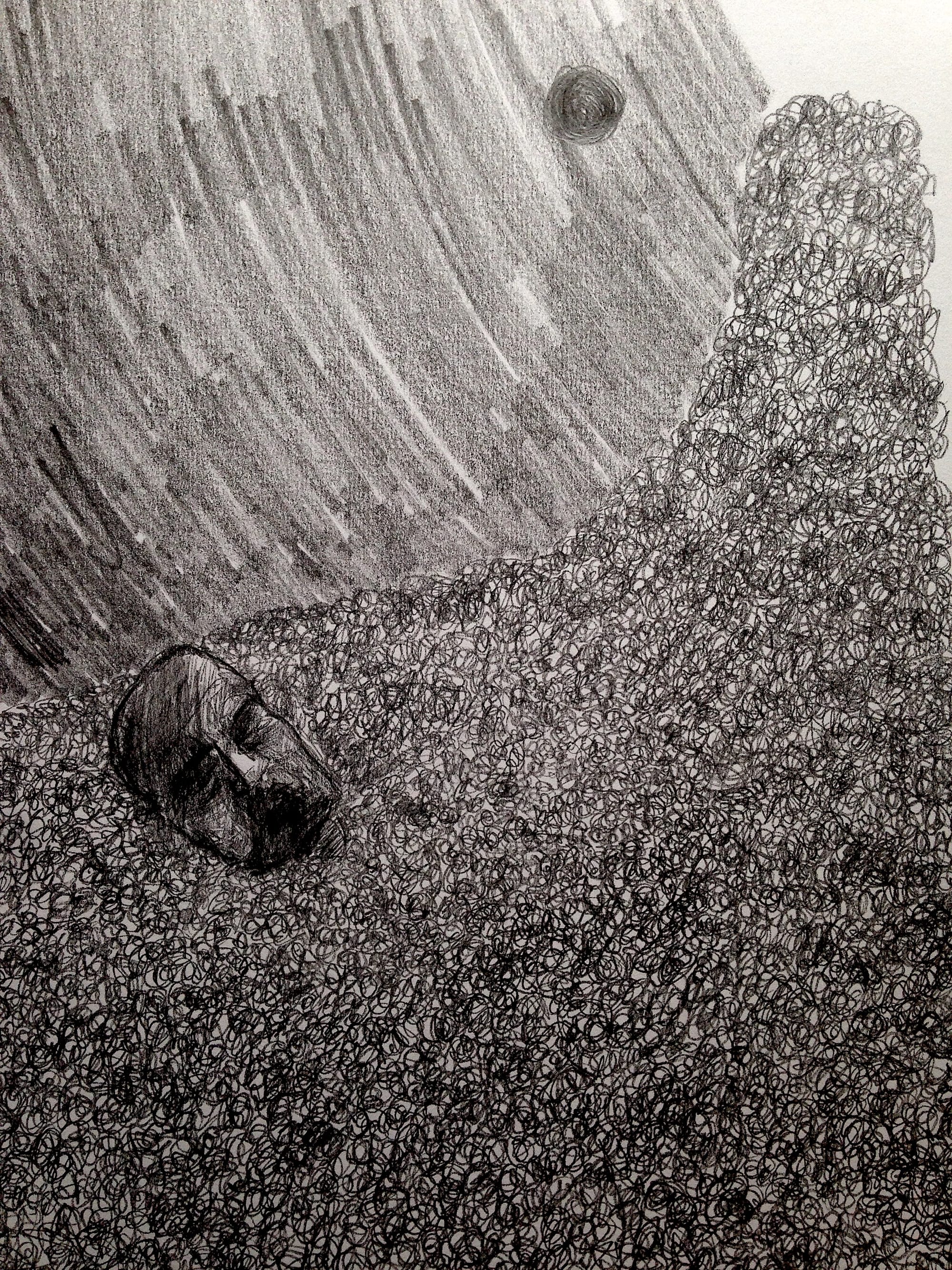
This reminds us of the political Marxism lying somewhere to the back of the Home style and the historical moment when Danish Cobra members Dotremont, Jacobsen and others were forced to break with the Communist Party over its support of Social Realism. And another layer to all this is the play with fictional names and shared identities. Right from the off Hockney is not Hockney just as the painter Constant was and wasn’t Nieuwenhuis, and Home was and wasn’t Luther Blisset, Karen Eliot, Simon Strong, K.H. Brown etc etc. Home inducts us into the reduced space – or expanded space depending on whether doubling halves or multiplies – and the writing, fluent and at ease with itself as Home at his best often is, becomes a product of itself, a disguised version of Isidore Isou’s chiseling.
The central idea behind "Chiseling" is the concept of "discrepancy," which refers to the gap between language and reality. Isou argued that traditional language is insufficient to express the full range of human experience, and that it is necessary to create a new form of writing that is based on the "chiseling" or "sculpting" of words. According to Isou, this new form of writing would be free from the constraints of grammar and syntax, and would allow the writer to express his or her innermost thoughts and emotions in a more direct and powerful way. Isou's approach to writing was highly experimental and challenged traditional notions of literature. He believed that language should be fragmented and reassembled in new ways, in order to create a more dynamic and expressive form of communication. This approach is reflected in his use of "discrepant" writing techniques such as "hypergraphy," which involves the deliberate misspelling and distortion of words, and "metagraphics," which involves the use of symbols and pictograms to convey meaning.
Of course Isou's chiseling has been highly influential in the development of avant-garde literature and art. It paved the way for other radical movements such as Concrete Poetry and Fluxus, which similarly sought to challenge the conventions of language and to create new forms of artistic expression. Isou's approach to writing also had a significant impact on the development of Lettrism, the movement he founded, which sought to create a new form of visual poetry that was based on the fragmentation and reassembly of words and letters. This has recently found new legs in the deranged Asemic , Collage , Concrete , Art , Minimalist, Poster and Originary Visual Poetry work of Vilde Bjerke Torset and her Scrypth magazine crew and Steven J Fowler's Poem Brut hoard.
Naturally Isou's chiseling has also been highly controversial, and has been criticized for its rejection of traditional literary values and its emphasis on fragmentation and disorder. Some critics argue that Isou's approach to writing is too radical and undermines the fundamental role of language in human communication. They suggest that his rejection of grammar and syntax undermines the clarity and coherence of his writing, making it difficult for readers to understand or appreciate his work.
Home chisels chiseling, and by chiseling chiseling writes highly organised, straight faced, grammatical and syntactically ‘correct’ pulp to refuse the fancy infections of genius-engorged, innovative and bourgeois writers. (‘Chiseling’ is Joke 8 in case you’re wondering. ‘Chiseling chiseling’ takes it to another level of course. It’s what Home does!).
‘No man in the RCA gave such breakfasts as Derek Boshier. Not the great heavy evening spreads for thirty or forty with an orgy afterwards, which came once or twice a term, when everything was supplied out of the college kitchen. You had to ask leave of the Dean before you could have it at all, and the Dean always insisted that the best looking boy was kept back to pleasure the staff . In those ponderous feasts the most humdrum of the first year MAs might rival the most artistic, if they could only pay their battle-bills, or get credit with the cook. But the daily morning meal, when even gentlemen commoners were limited to two hot dishes out of the kitchen, this was Boshier’s forte. Ordinary men left the matter in the hands of scouts and were content with the ever-recurring buttered toasts and eggs, a dish of broiled ham and bitter ale to finish. Boshier was not an ordinary man, as you instantly saw when you went to breakfast with him for the first time.’
This is a typical passage in Orgy. Home’s style runs in direct opposition to its message, understanding that there’s a problem with individuals who accept their function in the system who run up against the real world where other individuals reject their position in the system. This is the dilemma. It’s here as we are given David Hockney’s movement into the art world via various class distinctive, dramatised perspectives and are reminded of the wage-slaving, over-exploited millions lying outside of the art thrones. It’s a twisting and deeply sophisticated political destruction of idols. So it’s a version of Collings art joke 5, like I said earlier. And like he said, it’s not the sort of joke that’s done for laughs.
As always Home is discomfortable. He presents the reader with an extreme discontinuity. Art and innovation, self-expression, authenticity, identity become banalised, hypnotised by production and conveniences, sewage systems, elevators, bathrooms, washing machines and are therefore no more nor less than intensive propaganda in favour of the continuation of slavery by other means. The crass pornography of the systematic exploitation that the art mythomania regiments and continues, disguised as a utopian desire to liberate people from material cares by just looking the other way, is caught fiercely by Home in his constant obsessive set-piece image-making of Hegelian slave/master vaudeville. They are peppered throughout and are signs of the distorted pleasure/pain routines which, as always with Home, look both forwards and backwards. Forwards, to the Utopian hope of building palaces for vagabonds and prisoners, and backwards, to the chilling capitalist regimes of power and subservience that economies of eros and art exploit
‘Hockney started crying. THAT really turned Kitaj on, so he immediately increased the savagery of the beating he was dishing out. It didn’t take long for Hockney to give in completely and just lie there almost motionless. There was no movement on Hockney’s part beyond a heaving in his chest and shoulders brought on by sobbing. After Kitaj had finished whipping Hockney, he scratched him with his finger nails. Boy did the sub jump and scream! As Kitaj lessened the pressure from his nails to a light scratch, Hockney stopped crying and started moaning and moving his arse in slow circular motions. Kitaj took hold of the butt plug that he’d inserted into Hockney’s crack and started moving it in little turns and thrusts.’
Passages like this are therefore the data from which his novel can progress along the dual lines sketched before, both scientific research and hue and cry in the catacombs of the reader’s response. Writers walk with strangers like psychogeographers constructing vaunted constructions and possible appointments. Home is walking throughout in dark catacombs often shut to the public by producing texts of mobile and transformable structures, and so reading is invited as a Chtcheglovean nomadic existence. Of course, the transformation and destruction implicit in this carries a health warning.
Tied to mere reading as an art act, ie – art appreciation – that is a fatal flaw and opposes the Utopian ideal. Hence we are plunged into the s & m detournement on a grander scale than mere sensation and shock – for let’s be honest - which Home reader is genuinely shocked by anything in the elements he garners? Home isn’t writing out of any interest in the personal of course. Inspiration and personal properties such as identity, originality and authenticity are obstacles to anyone reading Home and to his whole project. His elements alter the meaning of his fragments and materials. The focus on the technology of the ‘rubber slave’ is scurrilous, without rhyme nor rhythm, and has in mind a drudgery akin to Dickens crucified at Charing Cross and improving his arithmetic by counting the lamp posts in Holborn.
Home’s work is here about the transformation of an environment captured by a myriad of relations and experiences that aim to mar scandal, and cultivate an air of, once more, the over-extended unfunny joke. His constant detailing are like imagined solutions to problems that don’t exist. In a sense he’s working within the courtyard of the College of Pataphysics – an academy without painting, without research into the imagination, fantasy, signs, symbols or anything, where all he wants is, in a sense, technical instruction. The writing reaches out to the kind of wonky Bauhaus collaboration, working hard to make a book based on a communication that would arouse and surprise outside rationalism or function, without taking into account utility or function, but done frantically and precisely in order to reveal it’s nomadism and roots in popular culture.
In this way the Utopian spirit rises out of the methodological rigor – although this is a rigor more promissory note than contract. The blueprints for exposing the tension between art world and real world come thick and fast. The David Hockney rubber slave trope is developed through Home’s relentless mapping of the territory. He twists the art fantasy slave escapism so that its link with real life exploitation is laid out and made plain. The reader can’t escape the inevitable pull of the juxtaposition. With ease, Home writes of the production of the rubber required so that the art dilatants can have their fun, and it's a rough and hard boiled treatment. Rubber involves slavery. The rubber slave fun between Hockney and Kitaj becomes part of the reactionary vanguardism of art world arrangements. Home makes this explicit in a long passage from a book Kitaj gives to Hockney which includes the following passage:
‘The gains from the exploitation of rubber through the state and other companies like the Anglo-Belgian India Rubber Company (ABIR) were huge. The original value in 1892 of the ABIR shares was 500 francs. In 1903 the shares had risen to 15,000 gold francs. The company felt obliged to let the bourgeoisie share profits with the upper class. The dividend in 1892 was 1 franc, but by 1903 the dividend was 1,200 francs. These enormous gains came from horrible exploitation and what Edmund Morel himself described as slavery. The scope of the destruction, together with disease and famine from forced labour, is estimated to have killed half of the native population of the colony.’
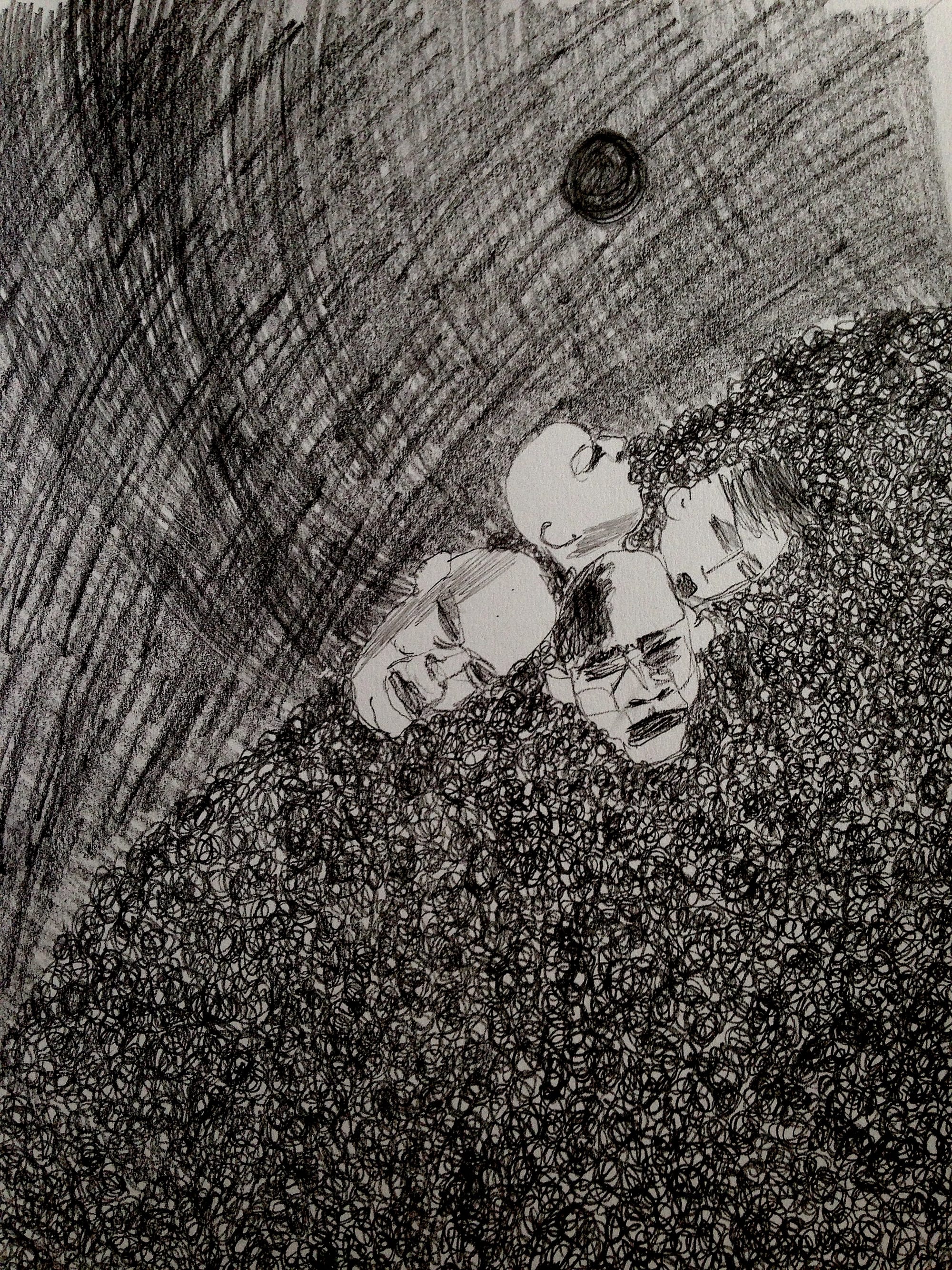
As ever, Home slickly includes historical events that expose the corrupting stagnating materialist processes smuggled below official idealist histories of art. He’s doing detournement in the ruins of the original ruins of noninvention, seeking to break the reader’s psychological identification with the hero so as to draw them into activity, provoking their capacities beyond reading to revolutionise their own lives. In so doing Home is drawing on the whole complex of the art milieu – its architecture, urbanism, poetry and cinema alongside the plastic arts and writing – to corrupt and problematise invention and noninvention both. All this adds up to Home working a sly unitary ambiance into his work, the sort of thing we get with SI jokes, such as the anti-painting of Gallizio - and reminding us of Home reminding us of the shitty expulsion of Ralph Rumney from the IS because he was too busy with the real life birth of his baby than furthering progressive art. And if this strikes us as insiderdom gone mad, it's just what the No 1 kind of joke Collings warned us about does. And again, who’s laughing?
Home’s novel has a slick, clear narrative. This is part of his attack on the cultural devastation caused by the automatic, functional attitude of the prevalent academic and stubborn mindlessness of the art world. The porno description of the Kitaj/Hockney relationship in the book is a version of the reversal of avant garde movements whose wish fulfilment is both elaborating the spectacle of refusal and the refusal of the spectacle. Why? Because the dialectic locks itself further into an art world attempting, again and again, to turn art into a new religion centered on refusing the world and its Utopian hankerings. It’s a complicated and delicate balancing act. Home uses familiar and worn tropes of rubber fetish porn in a relentless erosion of high culture norms as if his artifact at some level resists the description of ‘art’ and ‘culture’. An example of this is chapter eight, where Home runs through a list of ‘Cock and ball Torture’ routines and mechanics with a straight face. It’s a materialist description, aligned with those of cooks, shoe-makers and students of the liberal arts. It’s in one sense parodying the irrational reverence for the arts, the idea that somehow art is a superior type of knowledge and also a way of making art disappear from the galleries to reappear everywhere. In another sense it’s revealing the entire life of society in which modern conditions of production reign as an immense accumulation of spectacle where everything that was directly lived is moved away from life into mere representation.
‘II. Slapping
Slapping is another painful method of ball torture. While the sack of the testicles hangs loose, gently but firmly slap them from side to side. The testicles will bounce within the sack when they are slapped causing immense pain so it is wise not to slap them with too much force. You can also tie up the balls with a length of rope, tubing, or leather straps. To do this, gather the testicles in one hand and gently pull down. With the other hand, wrap the rope or other restraint device just above the balls and tie off . Once this is accomplished, tap lightly with the fingers on the now taut sides of the testicles.’
Well, this is scandalous and funny both (kind of), crossing boundaries and loosening illusions. It’s a revolutionary text because of the low-brow obscenity and matter of fact palinode – the revisionary poetics adequate to redemption processes of history and spiritual conversion. Home is here treating the empire of art excess and innovatory male inversion within a totality of its own creation and specto-situationist mythos (When I write like this I'm doing one of my best joke 1s, btw).
Home, ironically, and hilariously, is mobilizing a Biblical/Marxist occult excess whereby Adam falls and the Word becomes flesh to restore us to the real, lived world. There’s a gigantic humility aiming to restore us to Utopian paradise. Fallen secular history is redeemed. In Home the renewal figure is historical and secular, outside of any art revelation. Home is all about love and grace, about transforming the desert into Eden. His Hockney is the anti-Cato of Dante’s Divine Comedy. Cato in Dante is presented within an economy of Christianised sin and pride and therefore as ascetic humility. Time is a line not a circle. Redemption is new and breaks open pagan circles of history. In Dante Cato’s statue is eternal – symbolic of the figural relationship between biblical allegory and historical contingency. Dante adds Ovidean and Vergillian allusions to the Biblical statue first seen in Nebuchadnezzar’s dream, so history and prophecy are synonymous and history is theologized. Home is breathtakingly reordering the materialist, Marxist Utopian theology in a similar occult way, and just as Dante had his poets prophesying Paradise from hell, so too is Home creating similar constellations of detonating truths from the hell of an art world incapable of ever getting us Eden back. Phew!
Art is the orgy, its own sterile world, and if the reference to Dante seems a stretch note that Home is not beyond having Petrarch’s Satyricon role-playing within the text, even as Hockney protests it's just ‘boring heterosexual BDSM!’ The bizarre and destructive nature of these activities combined with structural simplicity and indeterminate duration mirrors the iconoclastic insights and activities of the Fluxus protagonists, like Yoko Ono who we’ve already mentioned in passing, and emphasizes that there’s no need to practice, show skill or prepare. It’s all action against serious culture and cultural imperialism – hence Hockney’s ‘I’m not interested in straights’ and Kitaj’s retort : ‘Hockney thinks he is gay not straight… There is no gay or straight in BDSM!”.
It’s a version of the propaganda of sabotage and disruption. It’s a principled, ethical and moral tactic of unprincipled, unethical and immoral tactics. The name-checked artists and other public figures – David Hockey the rubber slave, Kitaj the rubber fetish dom, Richard Hamilton the torture dungeon guru, Palozzi, Carel Weight the whipper, Boris Johnson, Donald Trump etc etc plus Lara the tickle fetishist and a reappearence of K.L. Callan, fictional author from Home’s earlier classic Sadean novel ‘69 Things to Do with Dead Princess’ – all work to sustain the book’s active political and cultural degeneration. It’s not a book about such degeneration but rather the equivalent of a broken violin filled with concrete.
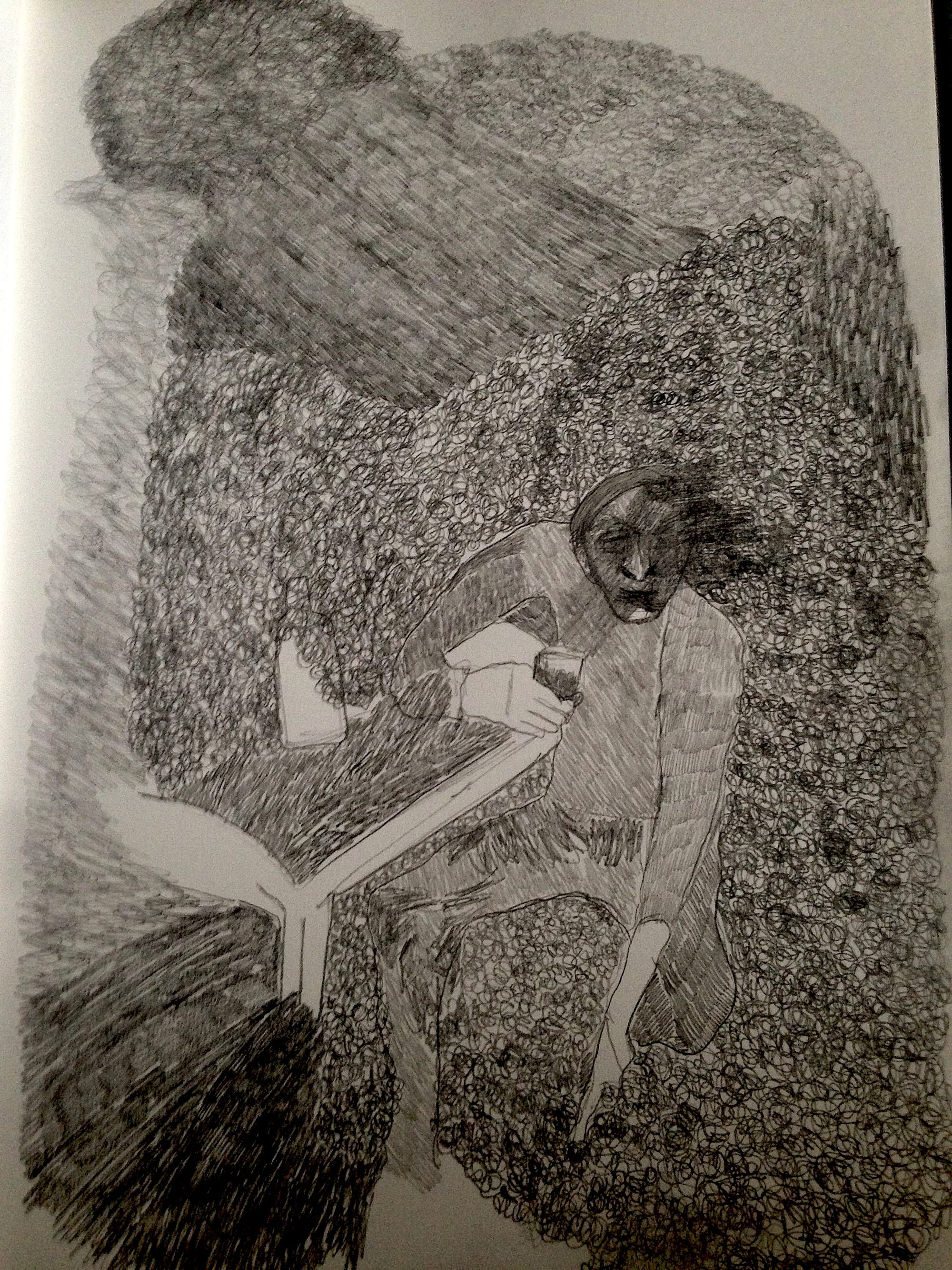
Home is working into the space outlined years ago by Henry Flynt who noted what he saw as an insurmountable contradiction between the fact that art objects existed independently of any subjective enjoyment of them and were created without regard for whether anyone actually liked them whilst artists expected their products ‘ … to find their value in people’s liking them.’ Flynt’s solution to this were ‘the experiences prior to art’ which he called ‘brend.’
It’s worth quoting at length from Flynt here:
‘Consider all of your doings, what you already do. Exclude the gratifying of physiological needs, physically harmful activities, and competitive activities. Concentrate on spontaneous self-amusement or play. That, is concentrate on everything you do because you like it, because you just like it as you do it. Actually, these doings should be referred to as your just-likings. In saying that somebody likes an art exhibit, it is appropriate to distinguish the art exhibit from his or her liking of it. But in the case of your just-likings, it is not appropriate to distinguish the objects valued from your valuings, and the single term that covers both should be used. When you write with a pencil, you are rarely attentive to the fact that the pencil was produced by somebody other than yourself. You can use something produced by somebody else without thinking about it. In your just-likings, you never notice that things are not produced by you. The essence of a just-liking is that in it, you are not aware that the object you value is less personal to you than your very valuing. These just-likings are your "brend." Some of your dreams are brend; and some children's play is brend (but formal children's games aren't). In a sense, though, the attempt to give interpersonal examples of brend is futile, because the end result is neutral things or actions, cut off from the valuing which gives them their only significance; and because the end result suggests that brend is a deliberate activity like carrying out orders. The only examples for you are your just-likings, and you have to guess them by directly applying the abstract definition. Even though brend is defined exclusively in terms of what you like, it is not necessarily solitary. The definition simply recognizes that valuing is an act of individuals; that to counterpose the likes of the community to the likes of the individuals who make it up is an ideological deception.’
Home’s book is a brend purge, working against dead art, intellectual art, imitation, artificial, high, serious, abstract, illusionist, mathematical art. It’s an act of playfulness on the dead killer heart of the establishment. It’s neither entertainment nor art but just pleasure doodling out of reality pointing to the completion in reality of Utopia. It’s a book signaling a profound dissatisfaction with the materials of the novel (his chosen art form here obviously). He has taken to the dirty book and it’s playful toughness and produced a new one like a machine of pleasure, an auto-destructive intensity. It’s a book fully adapted for industrial societies. It’s a self-destructive book amplifying the sounds and tropes of its rivals, with a different set of materials, aims and, impressively, life times. Rather as his earlier works took the scummy New English Library paperbacks and corroded them into new, brutal, playful, corrosive and self-destructive brend reading environments, this new book has taken shape out of the liminal and self-devouring activities of erotic and pornographic materials as if mounting a therapy against the irrationality of the capitalist system. It’s a form of institutional wasteland, a cultural nervous breakdown warping out of the sexual repression committed towards a revolutionary left-wing future against future wars and materialist Utopia.
But it’s also a novel. So now let’s turn to the explicit literary tradition informing his book, a tradition that overlaps but not completely with the art activities tradition sketched above. The power of the book lies in its endless list of orgiastic derangements, which of course takes us to the de Sade prototype, 120 Days of Sodom. Beckett points to the problem Home faces when he writes of de Sade’s vast novel:
‘The surface is of an unheard of obscenity & not 1 in 100 will find literature in the pornography, or beneath the pornography, let alone one of the capital works of the century, which it is for me.’
Of course Home isn’t interested in any straightforward assessment of the literature in or below the pornography, nor, for that matter, anything running vice versa. And this loops us back to Apollinaire who was the poet who initiated the ‘de Sade boom’, as Beckett called it, and who importantly saw de Sade as a key French writer, an important novelist and a rigorous philosopher. Home is misread if taken to be anything less than an equally serous writer despite the sulphurous output he’s been committed to producing over the last four decades. And that’s why it’s instructive to note this specifically literary tradition feeding into Home’s novels.
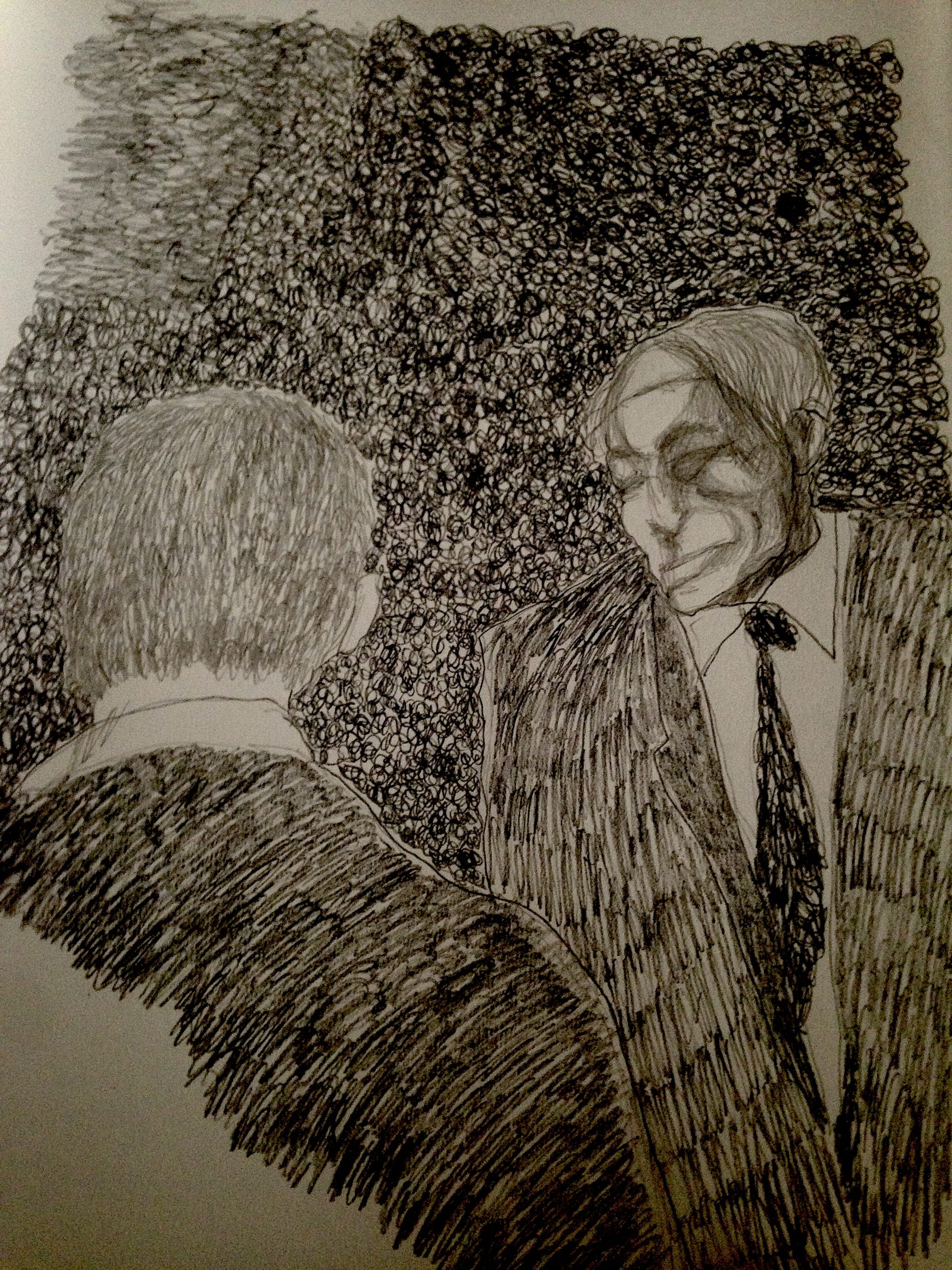
It’s a tradition that, if we start with de Sade and read via Apollinaire’s clues, runs through Levana & our Ladies of Sorrow, Laus Veneris, Belle Dame Sans Merci, Mademoiselle de Maupin, Une Nuit de Cléopatre, Le Roi Candaule, Anactoria, Lesbia Brandon and such. As Jean-Michel Rabaté in his brilliant ‘Beckett and Sade’ writes:
‘These titles refer to works by Sainte-Beuve, Jean-Paul Richter, Swinburne, Keats and Gautier respectively.’
Home’s novel can be seen as a further systematic examination of the Marquis de Sade’s influence on Romanticism and Symbolism, which culminates with Baudelaire, Flaubert and Sainte-Beuve taking in Edgar Allen Poe’s ‘imp of the perverse,’ Isidore Ducasse presenting a renewal of Sadean Gothicism in the Chants de Maldoror, the sadistic fantasies of Lautréamont and the surrealisms of Breton and Soupault. All this as well as Proust and Beckett, the modernist heavyweights, and Dennis Cooper, Steven Barber, Louis Armand, Johnny Pulp, Paul Holman, Bridget Penney and Steve Finbow as contemporary members of the gang.
Home presses upon us the reminder that the first manifesto of Surrealism defined de Sade with a quasi-tautology from Breton: ‘Sade is Surrealist in Sadism’ and that, as with his own survey of utopian currents within the avant garde, nothing stays still and everything mutates and changes. So we have Bataille’s take on de Sade contrasting with Breton’s, stressing a more materialist side to what both agree is an appeal to the often overlooked dark side of Enlightenment thinking. As Rabaté explains :
‘Georges Bataille would decide to appeal to a truly materialist Sade; this came as he was breaking with Breton, when Sade was the main example of a ‘base materialism’ that he felt was lacking in Breton. And then Breton’s second Surrealist manifesto from 1930 responded to Bataille by accusing him of being an ‘anti-dialectical’ materialist . The violence of this rejoinder had been triggered by Bataille’s own violence. Breton rejected the apocryphal vignette in which Bataille presented Sade locked up at Charenton, ordering a bunch of beautiful roses only to dip then into liquid manure.’
(And we can note, in passing, Collings joke 2 coming through here in this tradition, as well as many joke 4s) What we get in Home is the perverse thought that to outrage nature we might need to return to virtue. The Enlightenment Home praises is a delirious reason, as Maurice Blanchot argued in his works on Dada. The delirium that Home presents aims to express an inexpressibility that goes way beyond mere obscenity or transgression. He is opening up new spaces for writing and dragging his readers to the realisation that sadism lies in the accomplishments of the great post-enlightenment literature and thought. Home’s novel is an inheritor of this tradition, embracing a European decadence involving Baudelaire, Papetr, Swinburne, Schopenhauer, Nietzsche and Wagner. Swinburne’s Lesbia Brandon involves a male hero wanting to be punished by a female :
‘I wish you would kill me some day; it would be so jolly to feel you killing me. Not like it? Shouldn’t I! You just hurt me and see.’ She pinched him so sharply that he laughed and panted with pleasure. ‘I should like being swished even I think, if you were to complain of me or if I knew you liked it.’
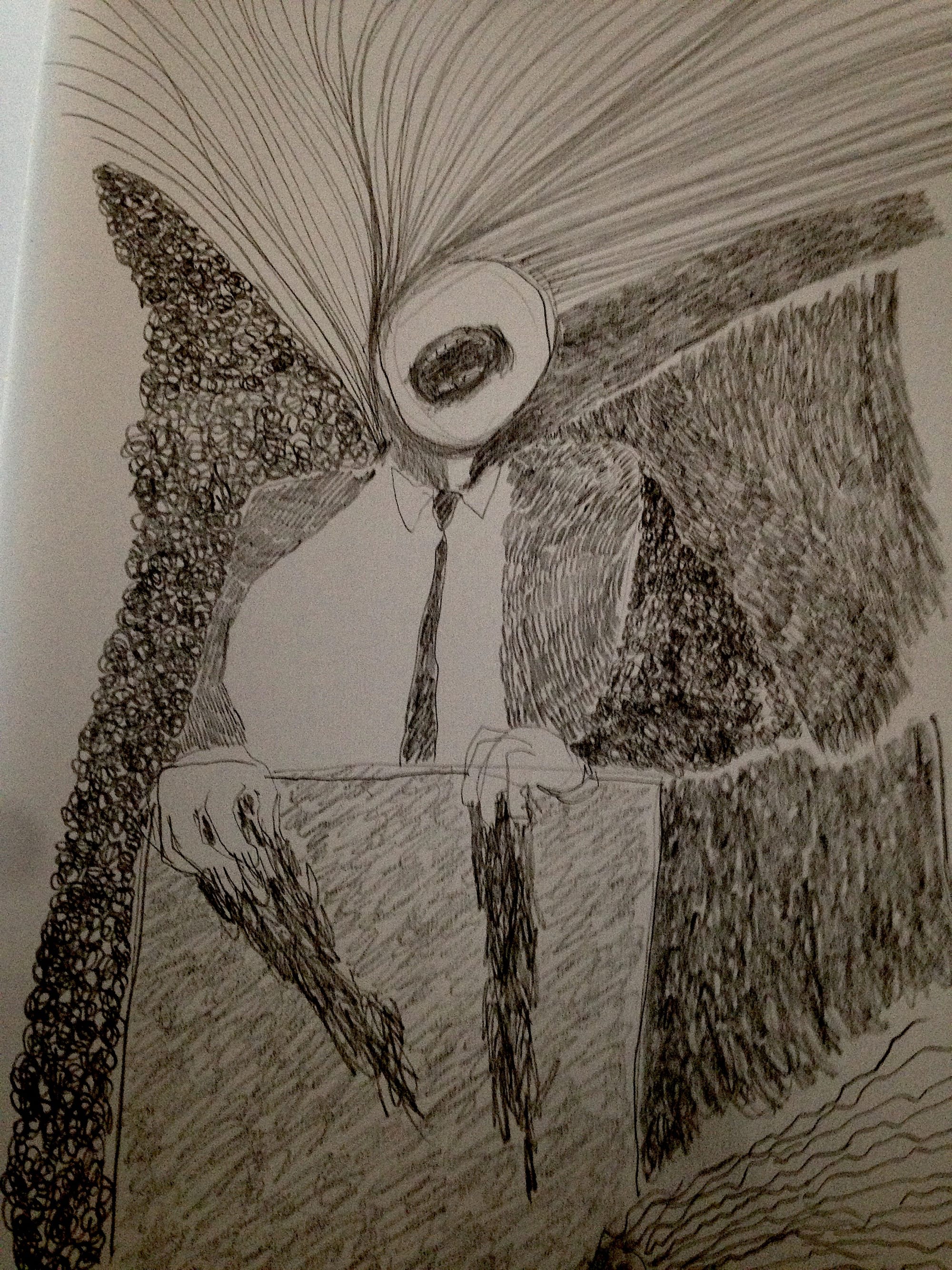
In this tradition literary sadism combines ‘satanism with a principle of reversibility between active and passive role,’ says Rabaté, and is found in Beckett’s first published story ‘Assumption’ which plays with expressionist tropes from Romanticism as well as German expressionism, linking it with both Robert Browning’s ‘Porphyria’s Lover’ of 1836 and the dramas of Oscar Kokoschka. In Beckett’s story the young willing male dies because of the orgasmic screams of the women. Beckett of course worked on translating de Sade and works his increasing interest and understanding of de Sade into various of his works.
Proust is another member of this tradition who writes of one of his characters in Recherche that:
‘ A sadist of her sort is an artist of evil, something that an entirely bad creature could not be, for then evil would not be exterior to her, it would seem to her quite natural, would not even be distinguishable from hers; and as for virtue, memory of the dead, and filial tenderness, since she would not be devoutly attached to them she would take no sacrilegious pleasure in profaning them. Sadists of Mlle. Vinteuil’s kind are creatures so purely sentimental, so naturally virtuous, that even sensual pleasure seems to them as something bad, the privilege of the wicked. And when they allow themselves to yield to it for a moment, they are trying to step into the skin of the wicked and to make their partner do so as well, so as to have the illusion for a moment, of escaping from their scrupulous and tender soul into the inhuman world of pleasure.’
In Home we get repeated moments of this tender soul entering the inhuman world of pleasure –
‘ Hockney was aware of the coppery smell of blood. Swallowing hard he realised his lip was split. He licked the swelling, cleaning the blood, awakening his senses to the pain that was turning into the delicious stinging ache he coveted so much. Hockney had a throbbing erection and concluded that Kitaj had been intent on arousing him in the quickest possible way, with physical abuse. Hockney shuddered with pleasure.’
Like Proust, Home has built a complex system of distributed frequent tortures to queery the role of pain and submission. In this the novel taps into the rootspring of Schopenhauer and the issue of pain and expiation facing justice. This literary tradition of course goes back further than de Sade. Dante’s Inferno is an example of the literary ‘logic of retribution founded upon a sort of divine sadism’ as Rabaté has it.
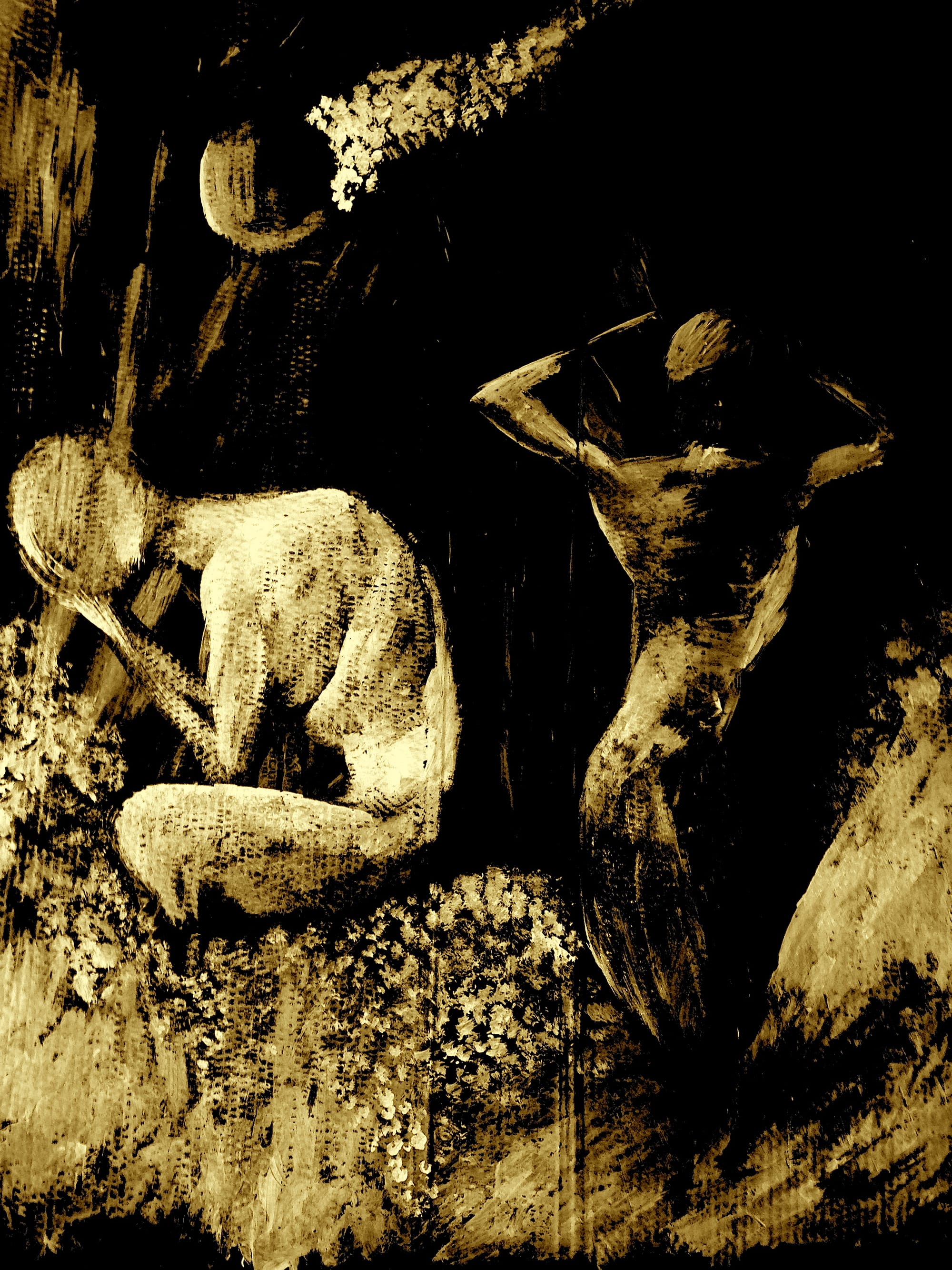
Rabaté links it to Beckett’s poem ‘Text 3’ which begins with the latin word ‘miserere’, the first word that pilgrim speaks to Vergil at the start of Inferno, and which places Dante with Proust in the poem.
‘Proust’s cook is in the study,
she is grieved in a general way for the abstract intestine.
she is so engrossed that she does not hear the screams of her assistant, a sloven she,
and the dying spit of a Paduan Virtue,
for alas she has stripped her last asparagus,
now she is smashed on delivery.
She rises,
her heart is full of murder and tears,
she hunts down the pullet with oaths,
fiercely she tears his little head off.’
Beckett insists on her cruelty, and in Proust’s Time Regained sadism occurs again and again. It is Beckett who first points to the purity of the sadists, and the overall lack of moral sense in Proust, explaining that ‘Proust is completely detached from all moral considerations. There is no right and wrong in Proust nor in his world’ .
Home is working in the same groove. What he presents in the relationship between David Hockney and Kitaj are objective and immanent contradictions over which Hockney has no control. Kitaj and Hockney work an elusively trite multiplicity of pretty conventional sadist routines generating endless pain and absolute jouissance that can only end when Hockney is ready to be discharged into the great art commerce world and become an art superstar.
‘As he spoke, Kitaj undid the dog collar around Hockney’s neck. “So I am uncollaring you. You are now a masterless man. We will never have sex again but I expect you to become an art world sensation. You must fuck your way to the top, and perhaps whenever you and another man rut, you will imagine that other man is me.”
Institutionalised sadism is in Home combined and resolved by a kind of warped selfless devotion in Kitaj, and his narrative pares down the obvious surreptitious turning of the art school orgy into an endless prep school of torture for the well being of Hockney, a Bruce Nauman clowning version of Salo, Pasolini’s version of the 120 Days.
What is quite clear is that at no point is Home out to seduce us with erotic images. If anything Home is directly on point with de Sade who is also completely disinterested in creating pornography. Each scene is rather a discourse on techniques and resources and has little interest in much else. What it inverts is a theology, perhaps a Rousseauesque naturalist theology, so that it is only through cruelty and pain that Hockney will be redeemed into the state fit for the art world. To be an art superstar Hockney is taught, through the orgy, to understand the voracious greed and frenzied panic that structures such ‘success.’ Home presents the unnameable humanity and its worst perversions as the law of the art world by jamming together the mechanical and the occult. And of course Home has bigger fish to fry than just the art world: the whole of our current state of pseudo-humanity is similarly trapped in this capitalist logic.
All this, then, is a further example of the dark Enlightenment that Sade illuminates and the following literary tradition in which Home is working explores. The sadism inverts Kant, the greatest of the Enlightenment philosophers. It is as a debauched slave rather than as a Kantian autonomous subject that Home’s David Hockney, following de Sade, finds freedom. In the insane fetishised reason of Kant, the Enlightenment becomes a debauched global capitalism where human concerns are ruled out and all is consumed by inhuman abstract laws. Kant stressed the disinterestedness of the ethical imperative and Home writes to this strenuous apathetic strength which, taken to a logical conclusion, allows for the enslavement of others for ones own pleasure, the systematised mechanisation of perversity – contra Kant of course.
De Sade and Home are both shaping their literature to critique this global capitalist ethic, an ethic discussed by Horkeimer and Adorno in precisely these terms and with reference to the literature of de Sade to boot:
‘ The precisely coordinated modern sporting squad, in which no member is in doubt over his role and replacement is ready for each, has its exact counter-part in the sexual teams of Juliette, in which no moment is unused, no body orifice neglected, no function left inactive. ... The special architectonic structure of the Kantian system, like the gymnasts’ pyramids in Sade’s orgies and the formalized principles of early bourgeois freemasonry . . . prefigures the organization, devoid of any substantial goals, which was to encompass the whole of life.’
It is in this field of literature that Home is clearly to be identified and read, and the chapter after chapter of the developing sequenced orgies creates a novel as a machine, a substructure constructed around the David Hockney body whereby all of the body’s sites are increasingly occupied and an open apparatus extends and increases the orgiastic architecture until nothing seems to exist outside of the orgy and no one is allowed to be alone within it.
What we are to do as readers is to become the good overseer, where we read in turn the pacings, lubrications, tightenings, changes and regulations of each permutation. What seem to be endless enumerations are reduced to combinations of a single metaphysical site. And this is a quasi-mechanical, industrial site whereby what the various instruments create is a kind of perverse industrial complex of energies and instruments transforming hot pleasures into work. The Sadean novel seen in this light can be understood as being of the same category as Duchamp’s ‘Bride Laid Bare by her Bachelors’, a piece of art working as an emblem of sexual mechanisation, a montage chain of eternal masturbation and materialised mechanical reproducibility. It’s out of this that it speaks directly to the conditions of capitalism, and makes clear why Home has yet again turned his eye to the art world and its commerce.
It’s worth pondering the relationship with Kant some more given he’s emblematic of Enlightenment thought. Kant’s ethics of course required that no one use another as a means because that reduced a person to a thing. Sex for Kant was using the sex organs of another as a means to ones own gratification. Only marriage could solve the problem sex introduced: ‘There is only one condition under which this is possible: that while one person is acquired by the other as if it were a thing, the one who is acquired acquires the other in turn,’ writes Kant in his Metaphysics of Morals.
The Sadean can take the formalism of Kant to a different place: crime is justified if regulated by universal maxims. Sadean literature is where Kantian ethics is taken to its logical conclusion. In Home we have the bland serenity of this extreme rationality whereby each refined orgiastic pleasure is presented in the language of impassiveness, sending up the Hegelian/Marxist dialectics of master/slave and revealing the dark side of Enlightenment universalistic ethics.
The terror inflicted on David Hockney is the supreme terror de Sade introduced into literature, as Blanchot argued, and which ‘... offered a good equivalent to Hegel’s interpretation of the Terror that took place in 1793 during the French Revolution as the moment when pure and abstract Reason was unleashed and viciously turned into abstract state violence against all subjects’, as Rabaté summarises.
Blanchot links Sade and Lautreamont, and what he writes of de Sade can equally be applied to Home. What is being said in the novel seems clear and yet seems at the mercy of something not being said, and the constancy of the derangements humourously work through a comedic movement from reason to reasonableness to pathology. And this thoroughness ends with what strikes the reader as a fulfilment of the logic of desire, which can’t be fulfilled and works a law of diminishing returns that demands cranking the machinery of desire ever higher.
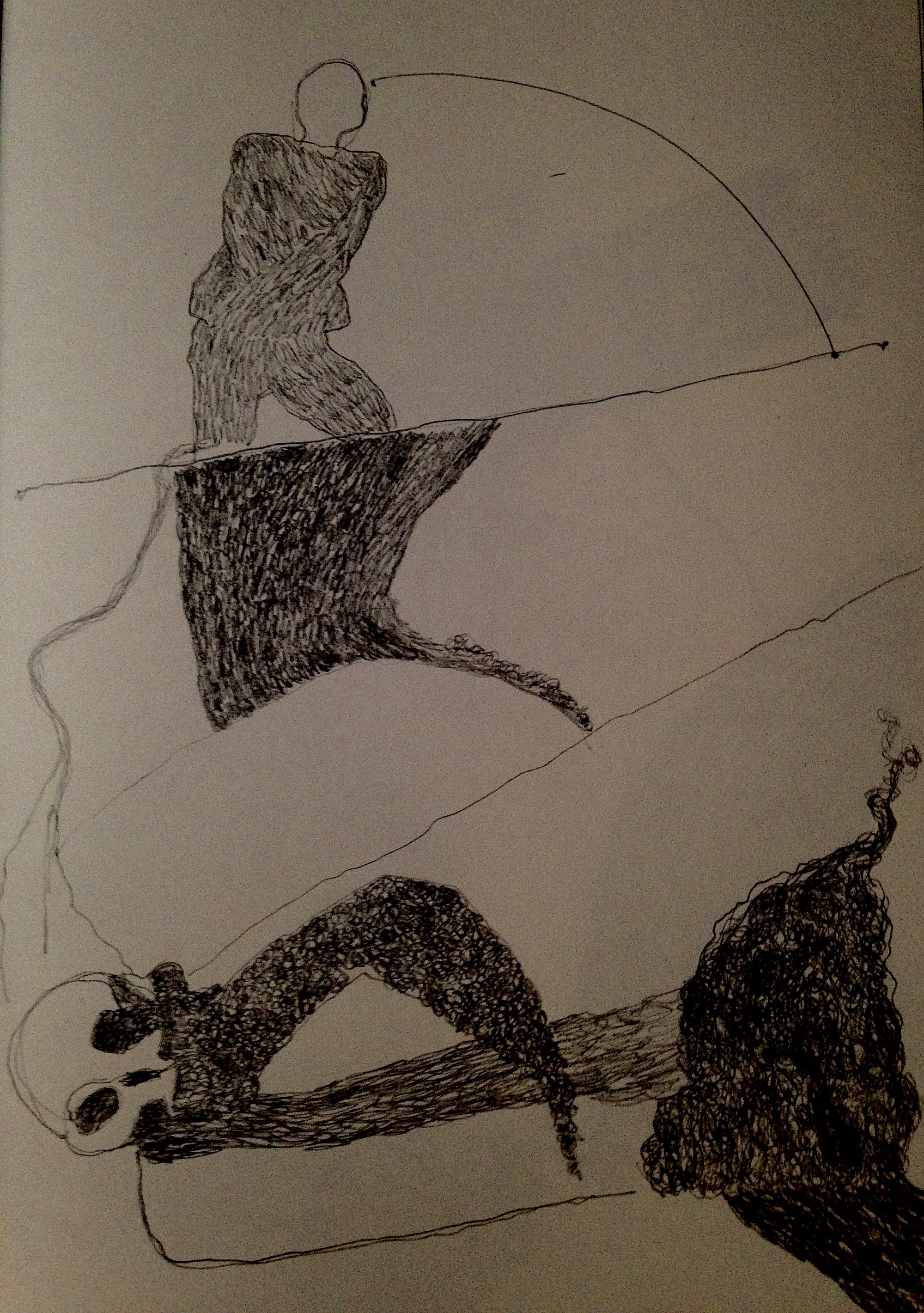
And all this works itself into the Schopenhauerian insight that all life is terrible and that the best activity is to prevent reproduction and have the species die off. The rejection of human kinship and reproductive laws are key elements of this Sadean tradition. In Sade children and mothers are particularly targeted. Home similarly uses familiar same sex fetish routines to staunchly refuse any reproductivity, picking up the humorous Sadean inversion that finds the continuation of the horrors of human life the true abomination. In so doing he’s parodying the idea of artistic self-generation, the idea of the artist as his or her own creator. The fantasies of the perverse imagination therefore rest on a conflict between the reproductivity of the imagination and the evil of reproduction as such.
In Home the punishments meted out to David Hockney seem a matter of precise, often literally mechanical, calculations, resulting in what seems to be a codified yet opaque system of eternal eroticised pain. Throughout we have the creation and continuation of what might be happily termed a cult of jouissance which prevents the rubber slave from falling into the sort of sullen sadness that afflicts any who are not continually refreshed with new perverse enjoyments. Home’s efficient detailing of each is clearly in the Sadean tradition which would include Giacomo Leopardi’s ‘ Life is merely bitterness and boredom, and the world is filth,’ Beckett’s ‘.. the fuck who suffers who makes us to suffer who cries who to be left in peace in the dark the mud gibbers ten seconds fifteen seconds of sun clouds earth sea patches of blue clear nights and of a creature if not still standing still capable of standing always the same the same imagination spent looking for a hole that he may be seen no more in the middle of this faery who drinks that drop of piss of being and who with his last gasp pisses it to drink the moment it’s someone each in his turn as our justice wills and never any end it wills that too dead or none’ , Dante’s ‘This hymn they have to gurgle in their gullets, because they cannot speak it in full words,’ and Bataille’s ‘ Without a profound complicity with natural forces such as violent death, gushing blood, sudden catastrophes and horrible cries of pain that accompany them, terrifying ruptures of what had seemed immutable, the fall into stinking filth of what had been elevated – without a sadistic understanding of an incontestably thundering and torrential nature, there could be no revolutionaries, there could only be a revolting utopian sentimentality'– the latter in particular emphasising the materiality of this Sadean and revolutionary tradition .
A left wing republican utopian politics is deeply enmeshed in Home’s novel, and explicitly referenced eg ‘When Hockney reflected on the matter he could see why. Kitaj had not ordered him to save the British establishment by letting a bunch of squaddies gang bang him in an occult ritual. On top of that Kitaj’s Jewish roots meant he had good reason to have given Hockney’s flirtation with neo-nazism short shift,’
‘Hockney put neo-nazism and his army contacts behind him and instead set his mind to making art and serving his master Kitaj. He spent much of the Easter holidays in Bradford and was glad to get back to London and Kitaj for his last term as a postgraduate at the Republican College of Art,’ etc etc.
What’s fascinating in Home is the way he brandishes both the monumental occult Satanist decadent strand within the tradition as well as its revolutionary materialist political strand. So we have both
‘ There was a man masquerading as the last head of the Knights Templar Jacques de Molay, with a large red cross over his chest. His companion was a crippled looking elderly lord encased in silk and wearing a turban held together with a ruby broach. Like Novotny, these two men were well aware that Jacques de Molay had been burned at the stake after being found guilty of worshiping Satan in the form of Baphomet, a corruption of the name of Prophet Muhammad. The man in silks carried a sultan’s magic wand made from a dildo and topped with a crescent moon cut from card,’
alongside Hockney the fascist brownshirt.
Obviously Home is splicing the two together so sex magic and right wing politics are bound up with the British Empire regime. Home’s text is a clear assault on the right wing hegemonic powers, drawing on the revolutionary forces of the inherited tradition unleashed by de Sade at the time of the French Revolution. Home is working the supreme blasphemy by showing the loathsomeness of this right wing stuff. Just as in de Sade, Home’s libertines are powerful, reactionary apologists for the right wing regime Home is out to satirise and attack. Their fascistic projects reveal the absurdity of linking freedom to sexuality per se.
This book is an anti-fascist machine but is subtle and precise, just as de Sade’s novels are. The anthropologist Geoffrey Gorer is helpful in spelling this out when , according to Rabaté, he ‘… sees in Sade’s novels a double message: a call for insurrection in the name of amoral excess, along with parodies of the delirious megalomania of proto-fascist speakers.’
de Sade argued that writers have a right to say anything. Home like Sade fights the distorting ideologies of our contemporary world. He’s disgusted with the illiberal right wing regimes that dominate us all, shocked by the mechanical terror of the war machines and capitalist decadence and is a true Sadean revolutionary. He is another example of de Sade’s dark enlightenment, exposing the link between tyranny, ideology and repressed sexuality and emphasising the equality between all men and women. de Sade’s Justine and Juliette highlight feminine heroines, appreciated by Angela Carter in her The Sadeian Women. Home of course uses male bodies in Orgy, but like de Sade the writing turns the bodies into insipid, near abstract, stagings. The body is seen from a distance through an effaced dull language stripped of individuality and ending in a fetishising of language itself. The writing is deliberately exhausted, creating throughout an excessively neutral atmosphere so that each event, each chapter, feels identical. The degraded human being is portrayed throughout within an entire system of totalitarianism, an imaginary reification of a battered humanity oppressed by perverse abusive powers that are clearly objective correlatives of the perverse capitalist system Home is battling. Home is serious, but writes in terms of a mockery of the serious via the apathy and neutrality of the language. (Collings joke 8).
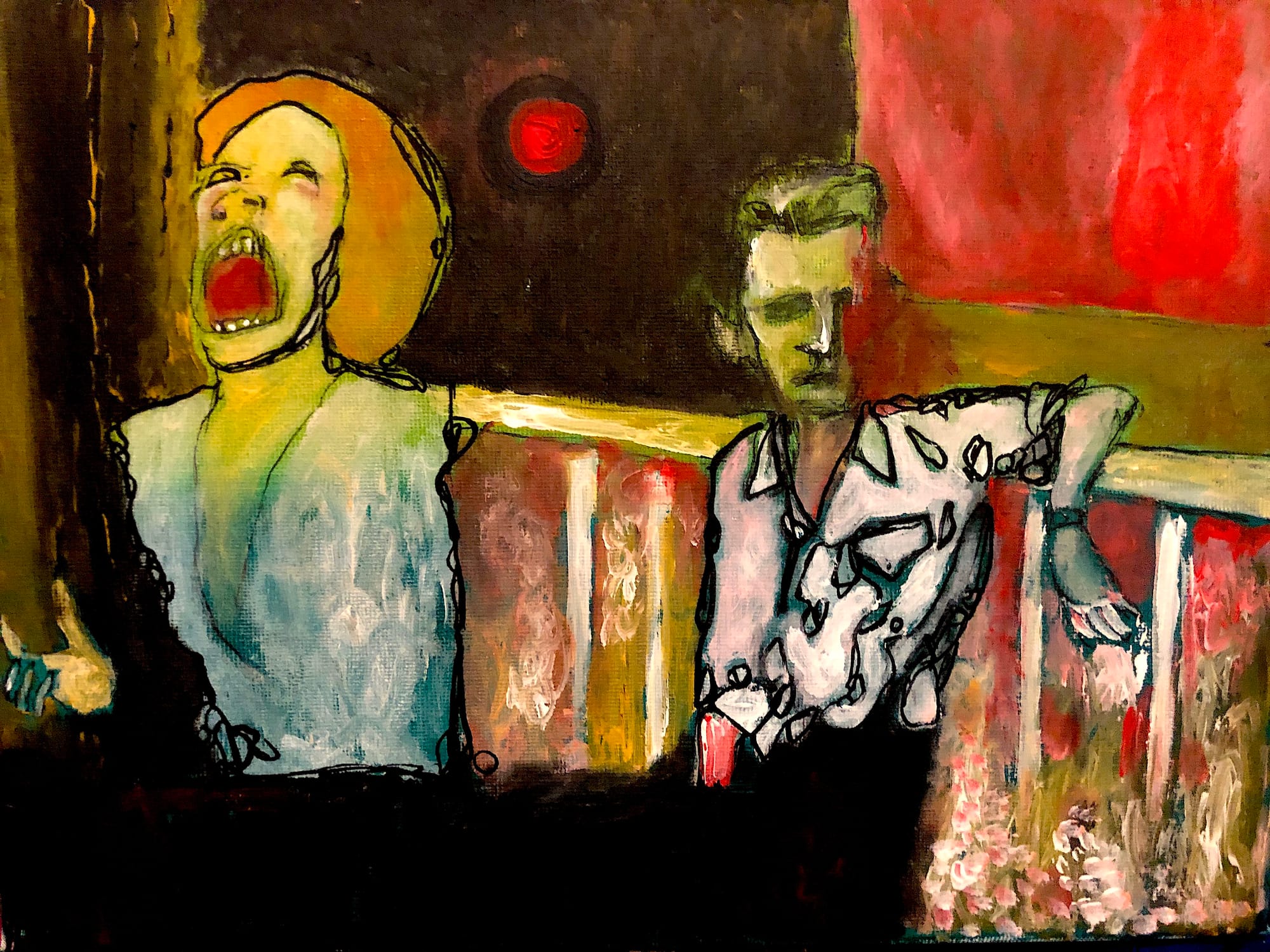
What Blanchot in ‘Sade’s Reason’ applies to Sade is equally applicable to Home:
‘ This is the grand irony – not Socratic, not feigned ignorance – but saturation by impropriety (when nothing whatsoever suits anymore), the grand dissimulation where all is said, all is said again and finally silenced.’
The strangely cursory endings that Home often employs and does so in Orgy remind us why there is rarely closure or finality in any of this. Rather, there is a sort of silence that is about having to live after confronting the endless catastrophe that comes before any ‘final act’ or dénouement. It’s a part of Home’s tactic to thoroughly dehumanise his subjects through a systematic use of abstraction. Only the use of names prevents the whole piece from being anonymous and undifferentiated. The hierarchy of authorities, the orchestrated interrogations and punishments, the progression of events through a spiralling of accumulation is Home reducing justice to a sadistic system in which all subordinates become disposable. What Home is constantly doing is extend the reader’s perception below representation to a level of classical discourse and thought. His discourse is deliberately repetitive and forces us to understand that there’s a dark level below representation that, in the endlessly repeating and recycling of violence and sexuality, requires the utopian freedom to write anything and everything. The repetitive style and lack of psychological depth ensures that the tortures and orgies are flat, monotonous, affectless and moves the reader to confront the distinctions between fantasy and reality and person and object.
Home immolates his imaginary character David Hockney to make the sufferings and the orgies last beyond what we might imagine as an unending immensity of ages, as everlasting, and so in this Home is not only working the Sadeian motifs but also subtly working Dante’s too – hell becoming an eternity of hell and the forthcoming Paradise an eternity of jouissance:
‘As he spoke, Kitaj undid the dog collar around Hockney’s neck. “So I am uncollaring you. You are now a masterless man. We will never have sex again but I expect you to become an art world sensation. You must fuck your way to the top, and perhaps whenever you and another man rut, you will imagine that other man is me.”
In this ending, Home’s Orgy remains a dark text yielding an intimation of ineffable joy nudging us, masterfully, towards Dante’s ‘I think I must have seen the universal/ Form of this great knot, for my joy increases/ Simply because I hear myself saying this’ (Paradise Canto 33) and Rabaté’s mischievous suggestion that Beckett’s ‘Godot’ is one of his darkest Sadeian names. Once denuded of the final ‘t’, Godot ‘… would pun on the tool so often used by Sade’s Libertines, the huge dildo called in French godemichet, or in slang, gode. We will remember that in Paris, in Beckett’s time, rue Godot de Mauroy was well known for its sex shops and brothels.’
Orgy finds Home working at the height of his considerable and disreputable powers. It’s an essential read.